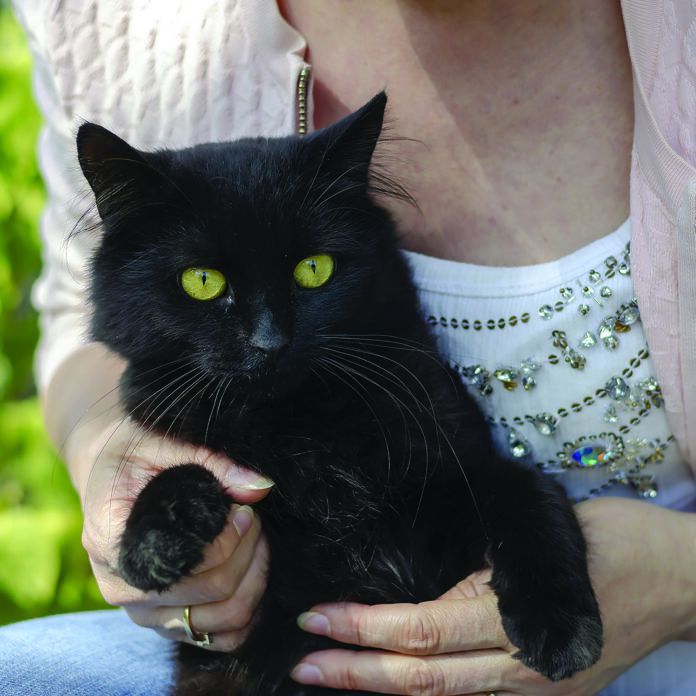While it would seem logical to assume that self-proclaimed cat people are more likely than others to physically interact with felines in ways that best suit their desires and temperaments, cat welfare scientists have found that those who rate themselves as knowledgeable and experienced with cats are more likely to touch them in ways they don’t like.
The scientists, hailing from the UK’s Nottingham Trent University and the University of Nottingham, looked at how each of 119 people interacted with three cats they did not know. Each of the three cats was paired with the person for 5 minutes. (There were 100 cats in the study altogether so that the same three cats were not used over and over.)
The way it worked was that all the participants were instructed to quietly enter the cat’s pen and sit in a corner facing the back. Additionally, they were asked to let the cat come to them and not to follow it. That way, the cats would be able to avoid interactions with the people if they wanted. But otherwise, the participants were encouraged to interact with the cats as they normally would at home.
To the researchers’ surprise, those who said they knew about cats and were used to spending time with them were the ones who were most likely to touch areas of the cats’ bodies that many cats find uncomfortable: the tummy and the base of the tail. Not only that, those who reported having lived with greater numbers of cats and for more years were also less likely to give the test cats sufficient choice and control during interactions — touching them more and initiating more physical interaction, even though cats feel more comfortable if they do the initiating. Perhaps not surprisingly, participants who fell into the category of “extrovert” on a questionnaire handed out by the researchers were more likely to initiate contact with cats rather than wait for the cats to initiate a physical connection and also were more apt to touch them on parts of their bodies that are generally less preferred.
Unfortunately, some people even went so far as to restrain the cats in their efforts to make contact with them — a feline no-no, as it completely removes a cat’s choice about being touched and about how it is touched.
The researchers theorize that perhaps people who are used to cats are more apt to touch them on all areas of their bodies with less thought given to where cats actually like to be touched. Or maybe it’s that people who are around cats a lot become too casual after a while about the fact that most felines are very specific about how and where they appreciate tactile sensation. But from a cat’s point of view, a casual, too-familiar approach is not good enough.
A quick refresher course in physical feline intimacy
Different cats have different capacities for togetherness, different thresholds for being held, touched, stroked, and kept company on the couch. And we assume you know your own cat’s limits and exactly where on her body she likes to be shown physical affection and what her signs are that she’s had enough. Still, whether you’ve had cats your whole life or are relatively new to them, it’s always good to keep the basics in mind. They will help you get along better even with a cat you’ve had for many years and with whom you have a great relationship.
- Let your cat make the first move. Generally speaking, cats prefer to initiate physical interaction rather than for you to do it. Wait for your cat to come over to you and rub against you, jump up on your lap, or otherwise let you know that it’s time for physical togetherness.
- Leave her wanting more. When your cat lets you know that she would like you to pet her, do so. Then stop. If she wants you to keep going, she will make that clear. Periodically do this throughout a petting session. It’s better to keep ascertaining whether a cat wants you to continue by taking a brief break rather than find out too late that you’ve piled it on too thick and end up scratched and rebuffed.
- Ears, chin, and cheeks. Some cats like to be stroked along their back, or even on their tummy — and many don’t. But it’s the rare cat who doesn’t like to be petted gently on her ears, the base of her chin, and lightly on the sides of her face. At the very least, start at those areas.
- Never — NEVER — restrain a cat so you can keep petting her. That’s an instant trust buster, and it will make her less likely to want to come over for attention and together time. Equally important, make sure any young children in your cat’s vicinity understand that rule.
- Know the signs for “I’m done.” Tail flicking, ears pushed down flat, the face going a bit rigid, perhaps a yawn — these are all indications that your cat has had enough physical interaction for now and you should stop.





My Smudge lets me know where she wants her petting , moving her head so my scritching ( light scratching ) is where she wants it. She doesn’t like stroking that much once in a while. She will “nip” my fingers if i stop too soon. She also loves to have us just rest a hand on her when she lays next to us. More then anything she loves to be talked to and will answer in chirps and twitters.
My seven month old kitten likes to snuggle up under my chin when I am reading in bed. Loud purring will begin when I oblige with ear and chin tickles often progressing to nose to nose touching and vigorous paddling, terminating any further literary pursuit. Victory! Cats rule – OK?!